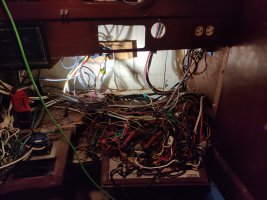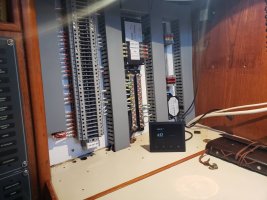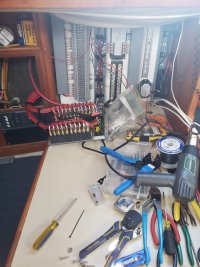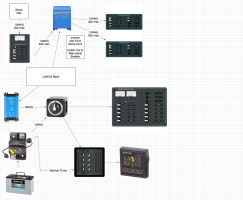You are using an out of date browser. It may not display this or other websites correctly.
You should upgrade or use an alternative browser.
You should upgrade or use an alternative browser.
Enjoy my electrical horror show
- Thread starter willo
- Start date
Frank Langer
1984 Ericson 30+, Nanaimo, BC
Yeah, there is no way to trace or trouble shoot to solve any problems in there. It will take work and time to rewire, but at least then you will understand your electrical system, which will be a huge help in the future.
Good luck with it!
Frank
Good luck with it!
Frank
Oh aside from the mess? I've already found a couple of undersized wires keeping things together. I had slated this as a best effort project but now I realize that it's much more of a safety hazard than I originally assessed it at.
Strategy today is to ensure that the spaghetti is complete de-energized and bypass a few circuits (via a small breaker panel) that need working while the boat is on the hard. For now, I'm disconnecting power whenever I step out of the boat.
Interior lights, fridge and at least one bilge pump get on the temp panel for now.
Someone got into a habit of running to the battery bay for some circuits, so I'll be yanking those and pulling them back up to the proper breaker location.
I'm planning on using DIN rail DC breakers for all of this so I can toss all the old bits. The DC breakers are certainly original 70s work. The AC panel has had a couple of updates, but it'll get the same treatment (with AC breakers of course)
All of the circuit wiring will run to terminator blocks.
Strategy today is to ensure that the spaghetti is complete de-energized and bypass a few circuits (via a small breaker panel) that need working while the boat is on the hard. For now, I'm disconnecting power whenever I step out of the boat.
Interior lights, fridge and at least one bilge pump get on the temp panel for now.
Someone got into a habit of running to the battery bay for some circuits, so I'll be yanking those and pulling them back up to the proper breaker location.
I'm planning on using DIN rail DC breakers for all of this so I can toss all the old bits. The DC breakers are certainly original 70s work. The AC panel has had a couple of updates, but it'll get the same treatment (with AC breakers of course)
All of the circuit wiring will run to terminator blocks.
If you're using DIN Rail DC breakers, you might want to try DIN Rail terminal blocks as well. It provides an easily expandable and reconfigurable block instead of being stuck with multiples of 12 with the standard terminal strips. It can make the project a little more expensive, but I've been really happy with mine so far.
Attachments
I quickly found out its next to impossible to keep everything clean, the next best thing was to cover it up and the open slot wire tray with a cap is a great way to do it. I used Velcro cable straps in the tray to keep it together while allowing expandability and easy cable tracing.
Attachments
I used, but 2 x 2 narrow slot with a cover. this isn't the exact part (I'm having a hard time finding my invoice), but close
https://www.graybar.com/narrow-slotted-duct-pvc-2-x-2-x-6-ft-/p/93150077.
There's lots of brands around, shop around and you should be able to find something that will work for a reasonable price.
https://www.graybar.com/narrow-slotted-duct-pvc-2-x-2-x-6-ft-/p/93150077.
There's lots of brands around, shop around and you should be able to find something that will work for a reasonable price.
I like Monoprice for stuff like this. https://www.monoprice.com/product?p_id=40367There's lots of brands around, shop around and you should be able to find something that will work for a reasonable price.
Pulled power and gutted the old panel out. More awful things (like really low gauge wires connected to much bigger circuits) were discovered.
I feel like a priest that just performed an exorcism.
I rigged up a pair of breakers for my DC lighting and my fridge. I'll tackle my bilge pump later but at least I'm no longer afraid to leave the boat power on.
I feel like a priest that just performed an exorcism.
I rigged up a pair of breakers for my DC lighting and my fridge. I'll tackle my bilge pump later but at least I'm no longer afraid to leave the boat power on.
I am re-wiring my 32-3 also. Finding a number of browned crimp connections pushed the decision over the edge about whether to re-wire or not.
Started burning money again. I opted for Blue Sea as I am familiar with their quality.
I had to discount paneltronics because of the obnoxious logo all over their panels.
Blue sea is less in your face, and I appreciate that. Ultimately this came down to availability and features.
Here's my plan for the AC Side:
1) Blue Sea 8102 ELCI breaker panel w/volt meter
2) 2x Blue Sea 8412 Main Panels - each has a 30A main + 6 breakers.
3) Victron Quattro 5000va Inverter
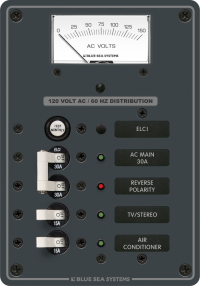
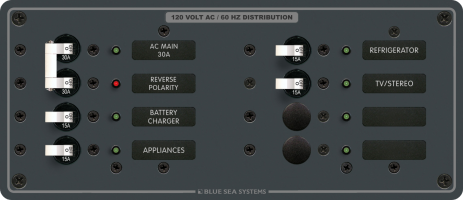
The ELCI breaker will bring the boat into modern safety standards. I approve of not electrocuting (most?) people.
I have a victron quattro 5000va inverter. It supports hybrid mode - grid+inversion and is built to accept 60A in and 60A out.
My shore connector will only be 30A, but I decided to optimize output by using a pair of 30A panels rather than retrofit a 50A main into a bigger panel. This also got me around supply limitations which are a pain right now. It also means that all my big AC wires are 10AWG - which is way easier to work with than 6AWG. This will give me the option to have a non-inverter circuit or two as well.
On the DC Side:
I've got a few tricks here.
1) Blue Sea 8068 DC panel.
2) Blue Sea 1455 4 position CLB Square
3) 4x SPDT toggles - Blue Sea 7482 switches
4) Blue Sea 1842 Bilge Monitor
5) Blue Sea 4 position battery selector switch
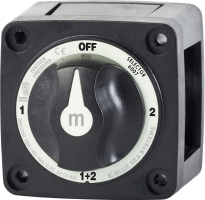
Working backwards, the battery selector switch is actually only to switch my 12v power source. Last time I returned to the boat, my shore power was out and I didn't have the house system fully wired yet. I popped in my AGM starter and was able to switch to it as a 12v source. This was super handy, so I'm keeping it. The switch allows for combining which also allows me to use my 70a 24/12 converter as a handy bulk battery charger for the AGM when needed. Reflecting further, I'm seriously thinking of adding a second AGM with an isolator as a spare starter cell.
Items 2,3,4 are all for my bilge pumps. I want to have auto and manual operation of my pumps, so I'm using the 1455 panel.
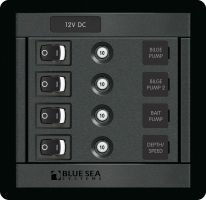
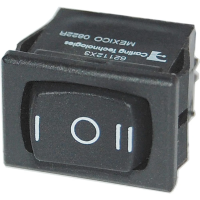
By swapping the toggle switches, I get breakers and three options for my pumps - on/off/auto. I want to be able to kill a given pump while troubleshooting/replacing.
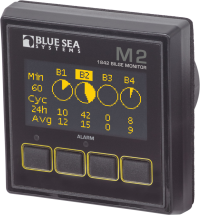
The Bilge monitor is there to keep an eye on pump run times and even provide alarming. A secondary high water alarm will also be in place.
It doesn't do anything to the bilge circuits but monitor them, which I appreciate - we want simplicity here.
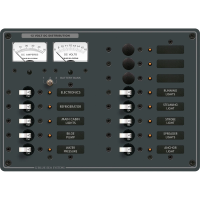
The 8068 panel was chosen because I like understanding current and voltage draw at a glance. My Victron display is awesome but having a simple gauge available cannot be underestimated in value. Again, this is partly a lesson I learned when returning to the boat and having to troubleshoot things. The old panel gauge was handy.
Not mentioned here are bus bars to terminate all the things... Still some shopping to do there.
I had to discount paneltronics because of the obnoxious logo all over their panels.
Blue sea is less in your face, and I appreciate that. Ultimately this came down to availability and features.
Here's my plan for the AC Side:
1) Blue Sea 8102 ELCI breaker panel w/volt meter
2) 2x Blue Sea 8412 Main Panels - each has a 30A main + 6 breakers.
3) Victron Quattro 5000va Inverter


The ELCI breaker will bring the boat into modern safety standards. I approve of not electrocuting (most?) people.
I have a victron quattro 5000va inverter. It supports hybrid mode - grid+inversion and is built to accept 60A in and 60A out.
My shore connector will only be 30A, but I decided to optimize output by using a pair of 30A panels rather than retrofit a 50A main into a bigger panel. This also got me around supply limitations which are a pain right now. It also means that all my big AC wires are 10AWG - which is way easier to work with than 6AWG. This will give me the option to have a non-inverter circuit or two as well.
On the DC Side:
I've got a few tricks here.
1) Blue Sea 8068 DC panel.
2) Blue Sea 1455 4 position CLB Square
3) 4x SPDT toggles - Blue Sea 7482 switches
4) Blue Sea 1842 Bilge Monitor
5) Blue Sea 4 position battery selector switch

Working backwards, the battery selector switch is actually only to switch my 12v power source. Last time I returned to the boat, my shore power was out and I didn't have the house system fully wired yet. I popped in my AGM starter and was able to switch to it as a 12v source. This was super handy, so I'm keeping it. The switch allows for combining which also allows me to use my 70a 24/12 converter as a handy bulk battery charger for the AGM when needed. Reflecting further, I'm seriously thinking of adding a second AGM with an isolator as a spare starter cell.
Items 2,3,4 are all for my bilge pumps. I want to have auto and manual operation of my pumps, so I'm using the 1455 panel.


By swapping the toggle switches, I get breakers and three options for my pumps - on/off/auto. I want to be able to kill a given pump while troubleshooting/replacing.

The Bilge monitor is there to keep an eye on pump run times and even provide alarming. A secondary high water alarm will also be in place.
It doesn't do anything to the bilge circuits but monitor them, which I appreciate - we want simplicity here.

The 8068 panel was chosen because I like understanding current and voltage draw at a glance. My Victron display is awesome but having a simple gauge available cannot be underestimated in value. Again, this is partly a lesson I learned when returning to the boat and having to troubleshoot things. The old panel gauge was handy.
Not mentioned here are bus bars to terminate all the things... Still some shopping to do there.
Last edited:
Frank Langer
1984 Ericson 30+, Nanaimo, BC
That looks very impressive! You clearly know what you're doing! I'm sure you'll be the envy of many on this site, and may expect many questions from others wanting to improve their electrical systems. 
Frank
Frank
Joliba
1988 E38-200 Contributing Member
Blue Sea is a great choice. We removed our rat’s nest over a decade ago and went with a Blue Sea panel for AC and DC. Simple to add new circuits, troubleshoot problems, and quickly monitor the status of everything electric. You’ll be quite happy once your work is done.
Worked around some issues and managed to get all the parts - that I know I need - in hand for my next round of boat work.
I had to get the 8 breaker version of the 1455 - couldn't find the little guys anywhere. Also got a handful of GFCI outlets.
I also ordered LOTS of bus bars, terminal strips and label maker heat shrink tubing!
I will be adding an isolation transformer but figure I can wait a month or two on that. I'm thinking of going full bore with the victron auto transformer that accepts 110 or 220 source...
I had to get the 8 breaker version of the 1455 - couldn't find the little guys anywhere. Also got a handful of GFCI outlets.
I also ordered LOTS of bus bars, terminal strips and label maker heat shrink tubing!
I will be adding an isolation transformer but figure I can wait a month or two on that. I'm thinking of going full bore with the victron auto transformer that accepts 110 or 220 source...
Tom Metzger
Sustaining Partner
Oops... an autotransformer is not an isolation transformer. It only has one winding which is tapped for different voltages. An isolation transformer has two (or more) separate windings which creates isolation between the boat and shore. The only connection is magnetic.
An isolation transformer can have two separate secondary (or primary) windings that connected in series or parallel will provide for 120 or 240 vac sources.
An isolation transformer can have two separate secondary (or primary) windings that connected in series or parallel will provide for 120 or 240 vac sources.
Victron makes an auto isolation transformer.
From their isolation transformer datasheet:
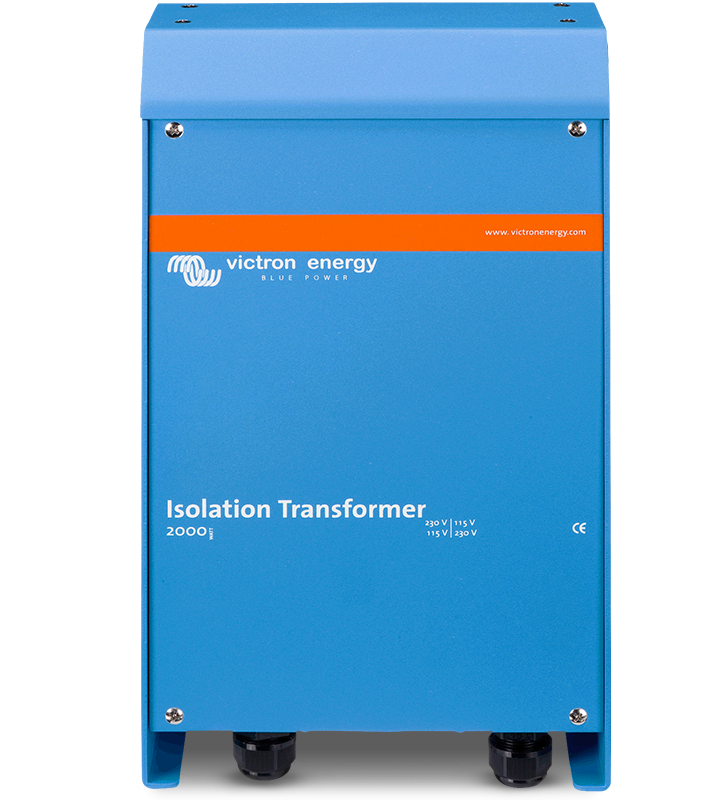
 www.victronenergy.com
www.victronenergy.com
3600 Watt Auto 115/230 V
This model will automatically switch to 115 V or 230 V supply, depending on input voltage.
Supply 88 V – 130 V: switches to 115 V supply
Supply 185 – 250 V: switches to 230 V supply range.
Note: The AC input voltage is raised by 1:1.05 ratio at the AC output.
From their isolation transformer datasheet:

Isolation Transformers - Victron Energy
Isolation transformers are essential in professional ship installations and prevent electrolytic corrosion. Ensure a safe electrical system.
3600 Watt Auto 115/230 V
This model will automatically switch to 115 V or 230 V supply, depending on input voltage.
Supply 88 V – 130 V: switches to 115 V supply
Supply 185 – 250 V: switches to 230 V supply range.
Note: The AC input voltage is raised by 1:1.05 ratio at the AC output.
Oops... an autotransformer is not an isolation transformer. It only has one winding which is tapped for different voltages. An isolation transformer has two (or more) separate windings which creates isolation between the boat and shore. The only connection is magnetic.
An isolation transformer can have two separate secondary (or primary) windings that connected in series or parallel will provide for 120 or 240 vac sources.

